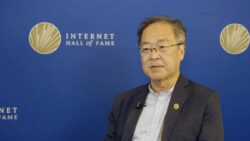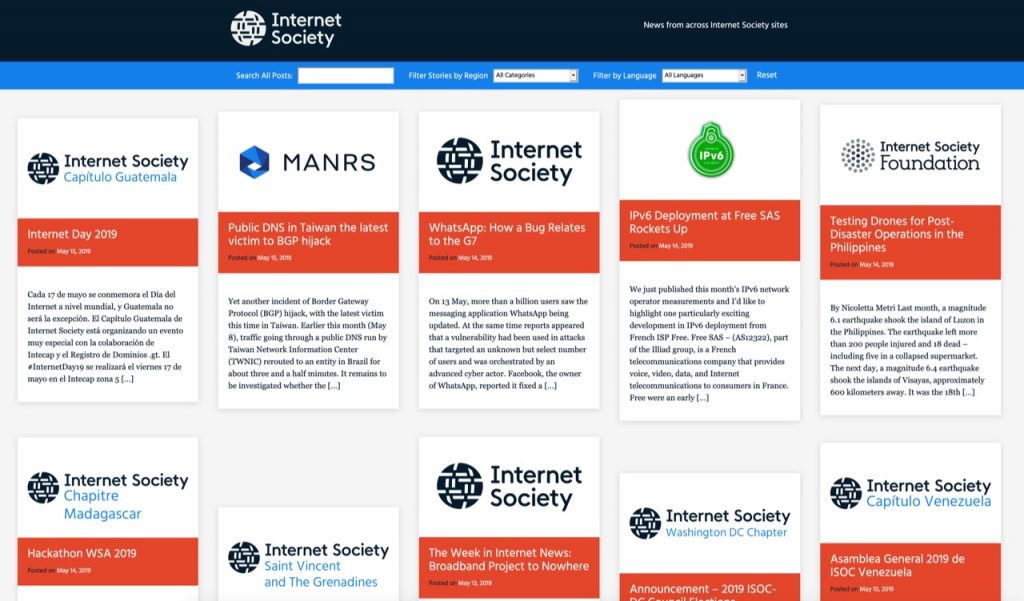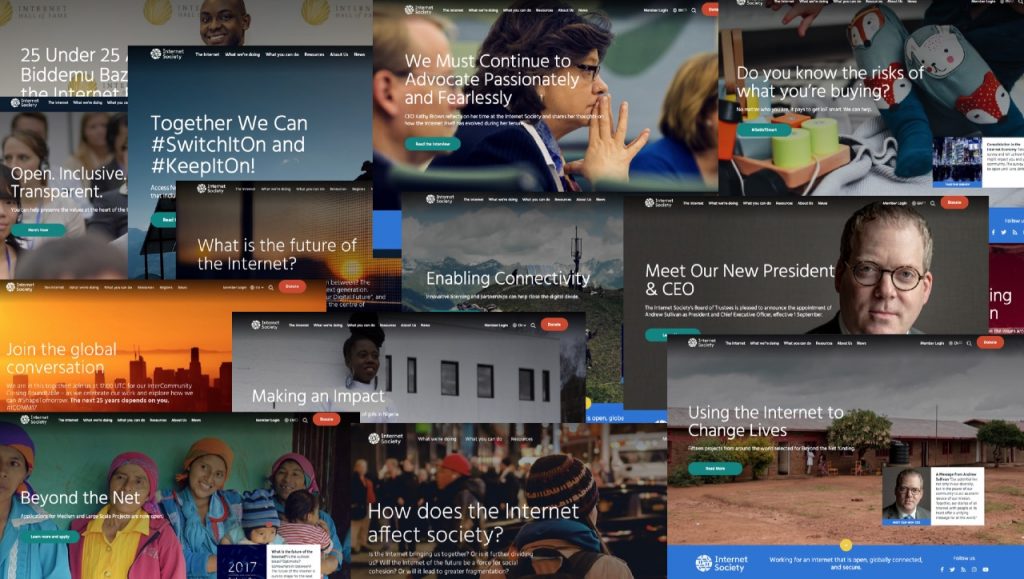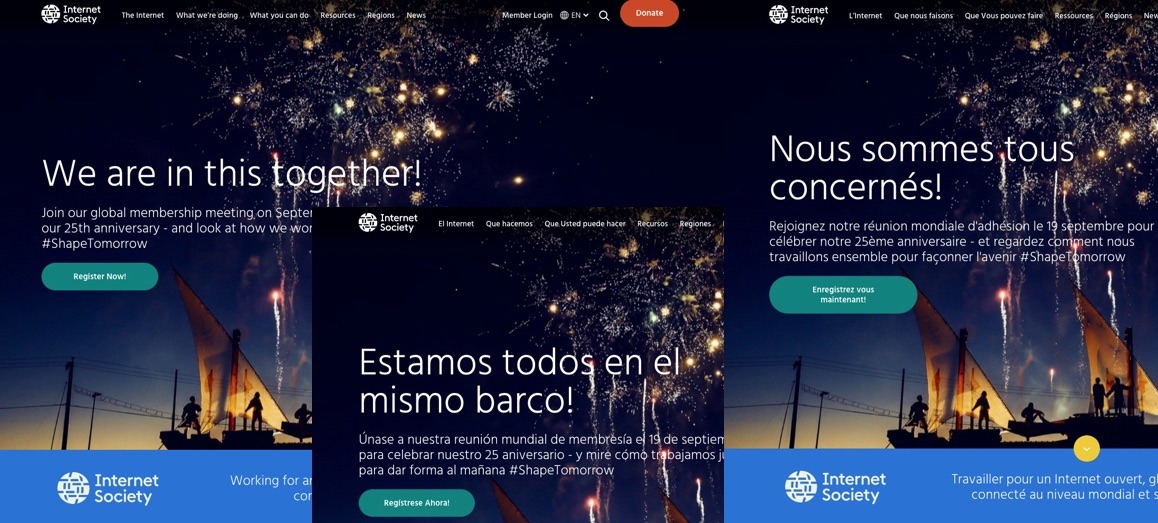
We honor Tadao Takahashi for all his work over many decades to build a bigger and stronger Internet, and to use the Internet to build a better society.
The post Remembering Tadao Takahashi appeared first on Internet Society.

Apr 07

We honor Tadao Takahashi for all his work over many decades to build a bigger and stronger Internet, and to use the Internet to build a better society.
The post Remembering Tadao Takahashi appeared first on Internet Society.
Feb 19
Today we have made some minor updates to the Privacy Policy for this site and most of our other affiliated websites. The changes from the previous privacy policy were: Clarified in the introduction that this privacy policy applies to sites from both the Internet Society and also the Internet Society Foundation. Previously, it said only […]
The post Minor Administrative Updates to Internet Society Privacy Policy appeared first on Internet Society.
Jun 25

Today I’m pleased to announce a new site we have built that brings into one location links to all the content published across Internet Society websites:
This news site aggregates posts from our main website, from sites of our 130+ Chapters and Special Interest Groups (SIGs), and from certain other affiliated sites. On the site, you can:
For instance, you can see all the posts published by Chapters in Africa. Or you can see all the posts published in French, or Spanish, or Chinese… or Georgian.
Note that the filters can work together. By choosing “Africa” and “French” you will see only French posts from African Chapters. There’s a “Reset” link on the right side that will clear all the filters.
All the views also have unique URLs that you can share with people, or link to from other sites, email newsletters, etc. And of course the site has a master RSS feed that you can read in a RSS reader or other tool.
I find it quite fun! It’s amazing to see all the great info being created by different parts of the Internet Society.
We encourage you to bookmark the page, add it to your mobile home screen, set it as your home page, or share it with others.
There are a couple of caveats to know about:
If you are curious about how we built the site, the site’s About page links to some of the WordPress plugins we used. You are also welcome to contact me directly with any specific questions.
If you look back at our Action Plan 2019, you’ll see that two of our goals are “Building our community” and “Strengthening our global voice” – we hope that this site will help with both of those goals by shining more light on what we are saying throughout our community and throughout the world.
We do hope your enjoy your exploration – and that through this site you may find more ways to take action to help bring about a more globally connected, secure and trustworthy Internet for everyone!
P.S. And again, I’ll mention the fun factor! For instance, the linguist / typographer in me is absolutely fascinated by the Georgian and the Armenian scripts. I have no idea how to read them, but it’s intriguing to me.
The post Announcing news.internetsociety.org – a way to follow what is published across all Internet Society sites appeared first on Internet Society.
Jan 24
On 31 January, 2019, we will be launching our new association management software (AMS) that will offer many new capabilities to Internet Society members and Chapters.
During the roll-out of the new platform, the current AMS will be offline for several days (details below).
Internet Society members will be familiar with our current AMS if you have ever clicked on the “Member Login” link in the upper right corner of this web page. You also used the AMS if you logged into our Connect member forums or took an online course using our Inforum system. Chapter leaders have become very familiar with our AMS over the years, as it is the way they have interacted with their members and performed administrative functions for the Chapter.
Due to some functional limitations with the current AMS, we are replacing the system with a new AMS that will provide:
We are very excited by the capabilities and how this new AMS will enable both our staff and our Chapters to be better able to communicate effectively with our members. This will help us all speak globally with a stronger voice, as well as enable you to deliver the services locally you need to in order to achieve your objectives.
In order to make this migration happen successfully, we will take our current AMS offline for several days. The downtime will begin at 22:00 UTC on Friday, 25 January and may extend to 22:00 UTC on Friday, 1 February.
During this time, our member portals will not be accessible.
The sites affected are:
All of our other websites will continue their normal operations.
The downtime will have the following impacts:
We want to minimize the downtime and hope that we will be able to bring the new system online before the 31 January launch date. As soon as we do, members will be able to resume these activities.
If you have further questions, please reach out to the transition team at amshelp@isoc.org
We look forward to providing you with a new and improved system serving our members and Chapters.
The post Introducing a new software platform that offers improved Chapter management functionality and much more appeared first on Internet Society.
Oct 29

The Internet Society Nominations Committee is now inviting nominations for candidates to serve on the Internet Society Board of Trustees.
In 2019, Internet Society Chapters and the IETF will each select one Trustee, and our Organization Members will select two Trustees. Following an orientation program, all new Trustees will begin 3-year terms commencing with the Internet Society Annual General Meeting in July.
The Board of Trustees provides strategic direction, inspiration, and oversight to advance the Internet Society’s mission of preserving the open, globally-connected, trustworthy and secure Internet for everyone.
If you or someone you know is interested in serving on the Board, please see the official Call for Nominations, additional information, and links to online nomination forms at:
http://www.internetsociety.org/trustees
The nominations period closes at 15:00 UTC on Friday, 14 December 2018.
The post Nominations Now Open for 2019 Internet Society Board of Trustees Election appeared first on Internet Society.
Oct 15
I must apologize to readers of our French and Spanish versions of our website. We are currently experiencing a problem with our usage of the WordPress Multilingual (WPML) plugin that is preventing us from sending our new content out for translation. It is proving to be quite difficult to identify and fix the issue. We are working with our development team, our hosting provider, and the WPML support team to find the solution. I hope that in the next couple of days we can solve this and return to our regular publishing in three languages.
Thank you for your patience.
P.S. Those who want more of the technical details can see the open WPML support ticket. You are also welcome to contact me directly at york@isoc.org.
The post Website update: Experiencing problems with translations into French and Spanish appeared first on Internet Society.
Sep 14

It is hard for me to believe, but it was one year ago today that we launched this new website! On September 14, 2017, James Wood began our flow of news with a welcoming blog post – and just a few days later the site was heavily used as part of our massive 25th Anniversary celebration. It was the culmination of a rather insane several months in which a whole crew of people within the Internet Society, as well as at our partners Moving Brands and ATTCK, all burned countless hours to make this site a reality.
One year later, we’ve published over 500 news articles and blog posts; published over 120 new resources and tutorials; promoted many events, and maintained a consistent flow of content on the critical issues affecting the Internet.
We’ve built campaign pages, integrated video and graphics (ex. our GIR page), showcased the amazing work our Chapters are doing, integrated social components (ex. our IoT page and Instagram), and pushed the limits of how many links any sane person should have on a page. I continue to be impressed by the beauty of pages like our Issues page (just move your cursor over the boxes) – or pages like our 2018 Action Plan with all its different rows and backgrounds.
And… it all works great on mobile devices – and we did it all in three languages!

Now, it wasn’t all smooth sailing, of course. As I wrote in some of the posts about our website redesign, we had our share of challenges. We went through three different search solutions until we found a system that worked. We initially had hundreds of thousands of 404 errors while we got redirects in place. We had some serious speed issues that made working on the site … sooooooooo…. incredibly… sssssssssssllllllllllooooooooowwwwwwwww… until we moved to a new hosting provider in June 2018.
But at this point I can say that overall we are definitely pleased with both the front end you see as visitors – and the back end we use to administer the site.
We are NOT done yet!
Launching a site is a long journey. There are still many changes and new features we want to introduce. We have a “timeline” feature we hope to be rolling out soon. We are working on a way to add interactive maps. There are some accessibility issues we still need to address. And we’re always working on increasing speed and providing a better user experience. Plus, we want to see how we can better integrate this main site with a few of our other affiliated sites.
There is a great team of people who have helped make this happen over the past year, and I look forward to working with them and many others to see what we can do with this site over the next year.
Our goal is to deliver on that mission for the site I outlined back in June 2017:
Our website is a driving force in realizing our mission of an open Internet for everyone. It empowers all who care about a free and safe Internet and inspires action to make a positive difference.
It demonstrates our global impact, promotes our point of view, and provides definitive resources on the news, technologies, and policies that shape the Internet – today and tomorrow.
It delivers a focused and engaging experience that connects with a breadth of individuals, organizations and influencers. It extends our reach, supports our community, and grows our membership, creating a foundation for building a stronger Internet.
We want to help you all who are reading this to work with us to help shape the future of an Internet that is open, globally connected and secure.
I welcome any comments and feedback on this site – you can email me at york@isoc.org or leave them on our issue tracker on Github.
Thank you for visiting this site, sharing our information, taking action – and helping us all to #ShapeTomorrow!
The post Celebrating One Year With Our New Website appeared first on Internet Society.
Jun 18
As you may have noticed, our shiny new website has some speed issues. It is slow for many visitors. Over the past few months we’ve worked on a number of potential changes to improve the site performance. One big change we’re making is to move to a different hosting provider.
That change will happen tomorrow – Tuesday, 19 June 2018 at 13:00 UTC.
Assuming all goes well, you shouldn’t really notice – except that the site should be faster! But if you happen to be browsing the site around 13:00 UTC, you might see some glitches on pages while the DNS magic happens and we change to pointing to the new server.
Once we’ve made this migration, I’ll write more about what we have done and how it has helped our site’s performance. Meanwhile, I just wanted to give a quick alert about this impending change to anyone viewing our site.
The post Alert – Web server host migration on June 19, 2018 appeared first on Internet Society.
Mar 28
As we built our new website, one of my own guiding principles was “POSSE“, a content publishing model from the “IndieWeb” movement. The idea is:
Publish on your
Own
Site,
Syndicate
Elsewhere
Essentially, make sure you own your own content – and then share it out onto other sites and services. (See the IndieWeb page about POSSE for more discussion.) Make your own website the “hub” for all your content, and then have spokes going out to all the other places where people might discover and learn about your content.
To me, this model is the best way to support the principles of the open Internet, while engaging people in the places where they already are.
This is part of a series of posts about the evolution of our new site.
We aren’t just publishing reports, papers, blog posts and articles for the sake of talking about what we are doing.
We are publishing content to bring about change that ensures the Internet remains open, globally connected, and secure. As we said in our vision statement for the new website:
Our website is a driving force in realizing our mission of an open Internet for everyone. It empowers all who care about a free and safe Internet and inspires action to make a positive difference.
Our website exists in support of our mission, of our 2018 Action Plan, and of our campaigns to shape the Internet of tomorrow.
But of course, once we publish content, the challenge is to get people to actually READ (and share) that content.
Sadly, we’ve not yet been able to convince everyone on the Internet to set www.internetsociety.org as their home page! (Have you done that yet? Would you consider it?)
So…. we need to share / syndicate our content out to the places where people may discover that content.
We need to go where people are.
The good news about the POSSE model is that WordPress brings many advantages. For instance, it has strong support of RSS feeds, allowing our content to be easily used by viewers – and also published on other sites. You simply add “/feed/” to the end of any URL for a category, tag, or author and… ta da… a feed of all the stories. Super easy and simple.
Unfortunately, the use of dedicated RSS readers has fallen out of style. So while this is an awesome feature, fewer and fewer people are using it.
Thankfully, WordPress also supports a variety of plugins that help with sharing our content out to other channels.
As we reach out to those other channels, it is critical for us to reach NEW audiences. If we only talk to the technical community out of which we emerged, or if we only speak to the “Internet governance” community in which we are involved, we will not be able to fully create the change we believe needs to happen.
We need to reach far larger audiences and help them discover what we are writing about. We need to reach the people who don’t know what “IoT” is – and help them understand why we need it secure by default. We need to reach people in areas without Internet connectivity – and help them understand how community networks can help. We need to reach people who can influence policy makers – and help their regulators understand how the Internet works, and how decisions around the Internet need to involve all sectors of society.
We need many people to take action.
Our ongoing work with the news media is a key part of reaching new audiences. We have had great success in this, and we will continue to expand our efforts. This is critical to our work.
Similarly, we also reach new audiences through building relationships with other media sites to get our articles published (or re-published/syndicated) on those sites. This can bring our ideas to whole new audiences that have not seen our site or even heard of the Internet Society.
But there has also been a large shift in how people discover news and content. For example, recent reports from the Pew Research Center found that 67% of Americans get at least some of their news from social media. For some groups and demographics, the percentage is even higher. Similar research from Pew showed a median of 35% of people globally getting news daily through social media.
Given these trends, it is critical for us to get our content out into the social channels where it can be found – and shared. Whenever we publish an article or blog post, we typically share it to at least:
(See our list of social channels.)
If we look a why we use each of these channels:
The sharing aspect is a key element. As the Pew Research study showed, people are more likely to trust news and links they see from their friends and family. So enabling people to share our content with others is critical.
Now, we don’t only “broadcast” out our content into our social channels. These channels are also one way we gather feedback and comments from people about our content.
We also do use other ways to engage with people in those channels. For instance, our recent polls on Twitter related to IoT and consumer rights. But the distribution of published content remains a major reason why we use the channels.
Beyond these social channels, we also syndicate and share our content out to other channels on a case-by-case basis. Some of those include:
Occasionally, we will also post content to some of the sites that aggregate links and provide news listings such as:
We also have used our Instagram account for some campaigns, too.
We are always watching for future channels where we should be engaging with people. One of the critical threads of the Internet Invariants is:
There are no permanent favourites.
Remember MySpace? or FriendFeed? or Jaiku? or… USENET?
The channels where people discover and engage with content today are not the same channels they used five years ago – and will probably not be the same channels people use five years in the future.
Facebook and Twitter are where a significant amount of people get their social news today – but will they still be the leaders in five years? Will enough people get upset at today’s platforms that they will actually engage in using new, alternative platforms?
As I look around at where people are engaging, I wonder whether we should do more with:
Or … whatever will be next? Will it be some blockchain mechanism? or…?
It’s hard to know. And to engage in new channels – and do it well – also involves some commitment of staff time and resources. But we will continually be watching, and evolving how we share our content.
Our commitment continues to be that we will Publish our content on our Own Site in support of the open Internet. And we will Syndicate that content Elsewhere.
We will go where the people are today – and we will keep watching and explore where the people will be tomorrow.
Our goal is to continue to empower people to take action in support of an open, globally connected and secure Internet.
The future of the Internet is up to each of us. We must work together to #ShapeTomorrow.
Image credit: Tom Kelly on Flickr CC BY NC ND
The post Building Our New Website: POSSE and Sharing on Facebook, Twitter, LinkedIn, Google+ and More appeared first on Internet Society.
Mar 08
The 2018 Internet Society Board of Trustees elections have begun!
Electronic ballots were emailed today to all voting representatives. They will have until Monday, 9 April at 15:00 UTC to cast their ballots.
In this year’s election cycle, Organization Members are asked to elect one Trustee to the Board. So voting representatives may vote for only one of the candidates on the Organization Members ballot.
Similarly, in this year’s election cycle, Chapters are asked to elect one Trustee to the Board. So voting representatives may vote for only one of the candidates on the Chapters ballot.
All new Trustees will serve three-year terms commencing in June.
Additional details on the elections, as well as information on all of the candidates can be found here:
https://www.internetsociety.org/board-of-trustees/elections/
To facilitate dialogue between OMAC members and candidates for the Organization Members election, and between Chapter leaders and candidates for the Chapters election, the Elections Committee has again launched an online Candidate Forum. In response to feedback from members, we moved the Forum from the Connect platform to a Mailman mailing list.
Everyone subscribed to the OMAC list was subscribed automatically to the ISOC Organization Members Candidate Forum list. Everyone subscribed to the Chapter-Delegates list was subscribed automatically to the ISOC Chapters Candidate Forum list. (You may unsubscribe from either list at any time.)
If you did not receive an email welcoming you to the Organization Members Candidate Forum list or the Chapters Candidate Forum list, please contact me.
We encourage you to familiarize yourself with the candidates and engage with your Organization’s voting representative or Chapter’s voting delegate on the choices this election presents.
Hiroshi Esaki
2018 Elections Committee Chair
Internet Society
The post Voting open for 2018 Internet Society Board of Trustees elections appeared first on Internet Society.